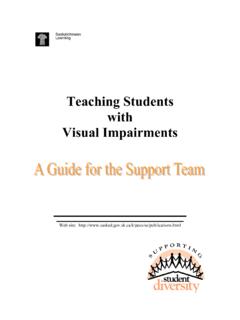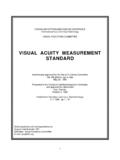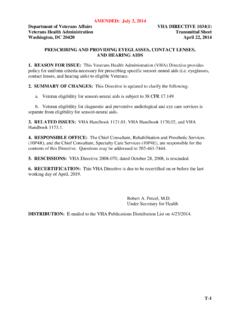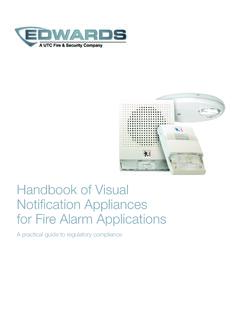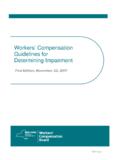Transcription of Key Findings - NPCBVI
1 Key Findings Indicators Percentage Prevalence of Blindness & visual impairment Prevalence of blindness in all age groups Prevalence of blindness in population aged 50 years Prevalence of severe visual impairment (SVI) in all age groups Prevalence of severe visual impairment (SVI) in population aged 50 years Prevalence of moderate visual impairment (MVI) in all age groups Prevalence of moderate visual impairment (MVI) in population aged 50 years Prevalence of early visual impairment (EVI) in all age groups Prevalence of early visual impairment (EVI) in population aged 50 years Prevalence of moderate severe visual impairment (MSVI) in all age groups Prevalence of moderate severe visual impairment (MSVI) in population aged 50 years Prevalence of visual impairment (VI-Blindness+MSVI) in all age groups Prevalence of visual impairment (VI-Blindness+MSVI) in population aged 50 years Major Causes of Blindness in population aged 50 years Cataract Corneal opacity (including trachomatous) Cataract surgical complications (including PCO) Posterior segment disease (excluding DR & ARMD) Glaucoma Major Causes of visual impairment in population aged 50 years Cataract Refractive error Cataract surgical complications (including PCO) Major Causes of Blindness in population aged 0-49 years Corneal opacity All globe/ CNS abnormality (Amblyopia) Phthisis Other/undetermined Major Causes of visual impairment in population aged 0-49 years Refractive error Cataract All globe/ CNS abnormality (Amblyopia) Corneal opacity Cataract Surgical Coverage (persons)
2 In population aged 50 years visual Acuity<3/60 visual Acuity<6/18 Cataract Surgical Coverage (eyes) in population aged 50 years visual Acuity<3/60 visual Acuity<6/18 Proportion of IOL Cataract Surgery in population aged 50 years With Intra Ocular Lense visual Outcomes (BCVA) after Cataract surgery in population aged 50 years Very good (can see 6/12) Good (cannot see 6/12 but can see 6/18) Borderline (cannot see 6/18 but can see 6/60) Poor (cannot see 6/60) 1 Introduction India was the first country in the world to launch the National Program for Control of Blindness in 1976. with the goal of reducing blindness prevalence to by the year 2020. In 1999, the WHO launched Vision 2020: The Right to Sight, a joint endeavor with IAPB, to eliminate avoidable blindness by 2020. In 2013, World Health Assembly adopted Universal Eye Health: Global Action Plan 2014-19 with an aim to reduce prevalence of avoidable visual impairment by 25% by 2019 compared to the baseline prevalence at 2010.
3 India has implemented a series of measures in its ongoing National Program for Control of Blindness and visual impairment (NPCB&VI) to combat blindness and visual impairment . The National Blindness and visual impairment Survey 2015-2019 was conducted in order to provide the evidence about the present status of blindness and visual impairment in India. The survey was planned by the Ministry of Health and Family Welfare, Government of India. Dr Rajendra Prasad Centre for Ophthalmic Sciences, AIIMS, New Delhi was responsible for planning and executing the field work, monitoring, analysis and report writing of the survey. The survey was conducted in partnership with various reputed Eye Health Institutes of the country. The Survey was conducted in aged 50 years population using Rapid Assessment of Avoidable Blindness (RAAB) strategy in 31 districts of 24 States/Union Territories of India from September 2015- June 2018.
4 This house-to-house survey was designed to generate representative data for the sampled districts as well as for India. Both rural and urban areas were included in this survey. An additional survey was conducted in 0-49 years age group in Jan-Feb 2019. This survey was conducted in 6 districts selected from six zones (north, south, east, west, central and northeast) of India. The results of both surveys, in 0-49 age group and in 50 years population, were used to estimate the prevalence of blindness and visual impairment in India across all age groups. Objectives of the survey To determine the prevalence of blindness and visual impairment (including avoidable blindness). To identify the major causes of blindness and visual impairment (including avoidable blindness) in India To estimate the cataract surgical coverage in India in 50+ population To ascertain the visual outcomes after cataract surgery in 50+ population To ascertain barriers for uptake of cataract surgery in 50+ population 2 Methods The survey in population aged 50 years was done using the Rapid Assessment of Avoidable Blindness (RAAB-6) methodology developed at the International Centre for Eye Health (ICEH), London and recommended by the WHO.
5 The RAAB survey methodology was developed as a rapid and cost-effective survey method for the assessment of avoidable blindness. A total of 31 districts were randomly selected among the districts in India for the survey and a sample size of 3,000 was calculated to represent each district. Hence, total sample size estimated for the 31 districts was thus 93,000. The districts and the clusters within districts were chosen using PPS (probability proportionate to size). sampling. Further, segments were identified within each cluster and one of them was randomly picked up and covered by compact segment sampling technique. The prevalence of blindness and visual impairment were assessed based on presenting visual acuity, followed by ophthalmic examination to rule out the causes of blindness and visual impairment as per the RAAB protocol.
6 A direct age and sex standardization of each district's survey data to that district's population age-sex structure was done as per the 2011 census, to estimate district-wise prevalence. Finally, in order to account for variation in population size of various districts, each district was allotted a sampling weight based on the district's total population aged 50 years. These weights were applied on the standardized district prevalence to calculate the overall prevalence across 31 districts, which was extrapolated to the entire country. 1. For 0-49 years population survey, sample size was estimated as 18,000 for the country. One district was chosen from each of the 6 zones of the country to ensure the heterogeneity of the sample population. A. total of 3,000 individuals aged 0-49 years were enumerated in each district.
7 In this survey, 30 clusters were selected randomly from each district and 100 individuals were covered in each cluster. Results of both these surveys were used to estimate the prevalence of blindness, SVI, MVI, EVI, MSVI and VI across all age groups in India. Based on the prevalence of blindness and VI, the total number of blind and visually impaired persons were extrapolated for the country for the year 2017. Definitions used in the National blindness and visual impairment survey Table 1: Definitions of blindness and visual impairment Blindness Presenting visual acuity < 3/60 in better eye with available correction Severe visual impairment (SVI) Presenting visual acuity < 6/60 3/60 in better eye with available correction Moderate visual impairment (MVI) Presenting visual acuity < 6/18 6/60 in better eye with available correction Early visual impairment (EVI) Presenting visual acuity < 6/12 6/18 in better eye with available correction Moderate severe visual impairment Presenting visual acuity <6/18-3/60 in better eye with (MSVI) available correction visual impairment (VI)
8 Presenting visual acuity < 6/18 in better eye with available correction Functional low vision A person with impairment of visual functioning even after treatment and/or standard refractive correction, and a visual acuity of less than 6/18 to light perception, or a visual field of less than 10 degree from the point of fixation, but who uses, or is potentially able to use, vision for planning and/or execution of a task. Blindness (BCVA/Pinhole <3/60) Best corrected visual acquity <3/60 in better eye 3 Result Survey in population aged 50 years Prevalence of blindness & visual impairment Out of 93,108 enumerated individuals with aged > 50 years in 31 districts, 85,135 persons were exam- ined with an overall response rate of The estimated prevalence of blindness was , SVI. , MVI , EVI , MSVI and VI Prevalence of functional low vision was and that of blindness<3/60 (using pinhole) was The prevalence of blindness and vi- sual impairment was lowest in Thrissur district (Kerala) and in Thoubal district (Manipur) respective- ly.
9 Bijnor district (Uttar Pradesh) had the highest prevalence of both blindness and visual impairment . 2. Table 2: Prevalence of blindness & visual impairment in population aged 50 years Indicators (based on better eye VA) Male 50 years Female 50 years Total 50 years % % %. Blindness (PVA <3/60) SVI (PVA <6/60-3/60) MVI (PVA <6/18-6/60) EVI (PVA <6/12-6/18) MSVI (PVA <6/18-3/60) VI (PVA <6/18) Functional Low Vision Blindness (BCVA/Pinhole <3/60) Figure 1: District wise prevalence of blindness in population aged 50 years Figure 2: District wise prevalence of visual impairment in population aged 50 years 3. Maximum prevalence of blindness was seen in 80+ age group ( ), followed by 70-79 age group ( ), 60-69 age group ( ) and 50-59 age group ( ). Figure 3: Age wise prevalence of blindness in population aged 50 years Blindness was higher among illiterates ( ) compared to literate population.
10 It was only among 10th pass and above. Figure 4: Literacy wise prevalence of blindness in population aged 50 years Blindness was more prevalent in the rural population as compared to urban population. vs Figure 5: Urban rural wise prevalence of blindness in population aged 50 years 4. Causes of blindness and visual impairment Cataract was the principal cause of blindness ( ), severe visual impairment ( ), and moderate visual impairment ( ) (Table 3). The other important causes of blindness were corneal opacity ( ), cataract surgical complications ( ), posterior segment disorders excluding DR and ARMD. ( ) and glaucoma ( ). Principal causes of severe visual impairment other than cataract were cataract surgical complications ( ) and other posterior segment diseases excluding DR and ARMD. ( ). For early visual impairment , the most important cause was refractive error ( ).
